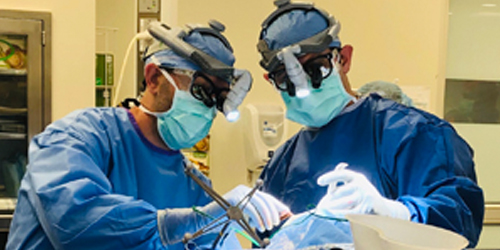By Yair Gozal, MD, PhD

Cavernous sinus meningiomas – benign yet threatening tumors – are lodged in a most inconvenient location. They sit above the skull at the base of the brain, surrounded by no fewer than five cranial nerves and the internal carotid artery. Treating these tumors without harming the micro-anatomic structures that are vital for function is one of the neurosurgeon’s great challenges.
Management options for a cavernous sinus meningioma are not always clear. Should we perform surgery or not? Should we treat the tumor with precisely targeted beams of radiation? Or should we simply keep a careful eye on the tumor and hold off on intervening?
In the 1980s, armed with new microsurgical techniques and heightened anatomical understanding, surgeons approached the cavernous sinus aggressively, with the goal of removing the entire tumor. The profession backed away from that strategy, however, because it led to unacceptable results, including injury to nerves and blood vessels. Surgeons also saw the tumors grow back, partly because tumor cells had infiltrated cranial nerves and an important vessel (the cavernous carotid artery).
Stymied by the realization that surgically removing the entire tumor was not feasible without causing collateral damage, brain tumor specialists reacted by treating these tumors with precisely targeted stereotactic radiosurgery. This strategy worked well for smaller tumors located within the cavernous sinus, but the treatment could cause complications when applied to large tumors whose borders extended beyond the cavernous sinus and caused compression of the optic nerve.
Today we realize that the best way to manage large cavernous sinus meningiomas involves both surgery and radiosurgery. First, we perform decompressive surgery of the cavernous sinus. We open up this anatomical region and remove (debulk) all of the tumor tissue that we can in this “safe” area. This frees up the cranial nerves, allowing their function to return. It also allows for safer radiation of the tumor that remains within the cavernous sinus. As a result, we see outcomes related to tumor control rates that are equivalent to radiation alone, while seeing outcomes related to cranial nerve function and surgical complications that are much better than what we could get with surgery or radiation alone.
A recent retrospective study, which I had the privilege of leading with my fellowship mentor, examined 50 patients treated with this dual protocol over a 15-year period (2002-2017) at the University of Utah. The largest study of its kind, it was recently published online in the Journal of Neurosurgery. Our approach emphasized safe tumor resection and direct decompression of the roof and lateral wall of the cavernous sinus as well as the optic nerve. Half of the patients also underwent radiation of their remaining tumor. Our study concluded that this treatment method was “an effective oncological strategy” that achieved “excellent tumor control rates with low risk of neurological morbidity.”
Tumor control was achieved in 90 percent of the 50 patients in our study. Only 5 patients saw their tumors grow back, with the median time to recurrence being 4.6 years. Patients who suffered cranial nerve deficits prior to surgery showed dramatic improvement of some symptoms, though not all. A minority of patients (20 percent) developed new neuropathies, a third of which resolved. Ultimately, our paper stated that “permanent new cranial neuropathies affected 5 patients (10 percent).” A handful of surgical complications, including minor stroke, were a reminder that complex neurological surgery in the skull base will always entail risk.
Mayfield neurosurgeons have the capability to treat these, and other similarly challenging brain tumors, at Cincinnati’s Good Samaritan Hospital and The Jewish Hospital – Mercy Health. Physicians and patients need to know that radiosurgery alone is not always an optimal treatment solution for a complex cavernous sinus meningioma.
We have shown that for specific subsets of patients – those who have a large tumor component that extends outside the cavernous sinus and causes compression of the optic nerve – surgery is feasible and beneficial. These patients ultimately do better with surgery and radiation than with just radiation alone.
Meanwhile, patients with small, slowly progressive tumors confined to the cavernous sinus can be effectively treated with radiation alone, while patients whose tumors are asymptomatic in general are just watched.
To view the entire publication (“Outcomes of decompressive surgery for cavernous sinus meningiomas: long-term follow-up in 50 patients”), go to https://www.ncbi.nlm.nih.gov/pubmed/30771770
Yair Gozal, MD, PhD, is a neurosurgeon and brain tumor specialist with Mayfield Brain & Spine in Cincinnati. He completed a fellowship in skull base and open cerebrovascular neurosurgery at the University of Utah in 2018. He performs brain tumor surgery at The Jewish Hospital – Mercy Health and Good Samaritan Hospital.